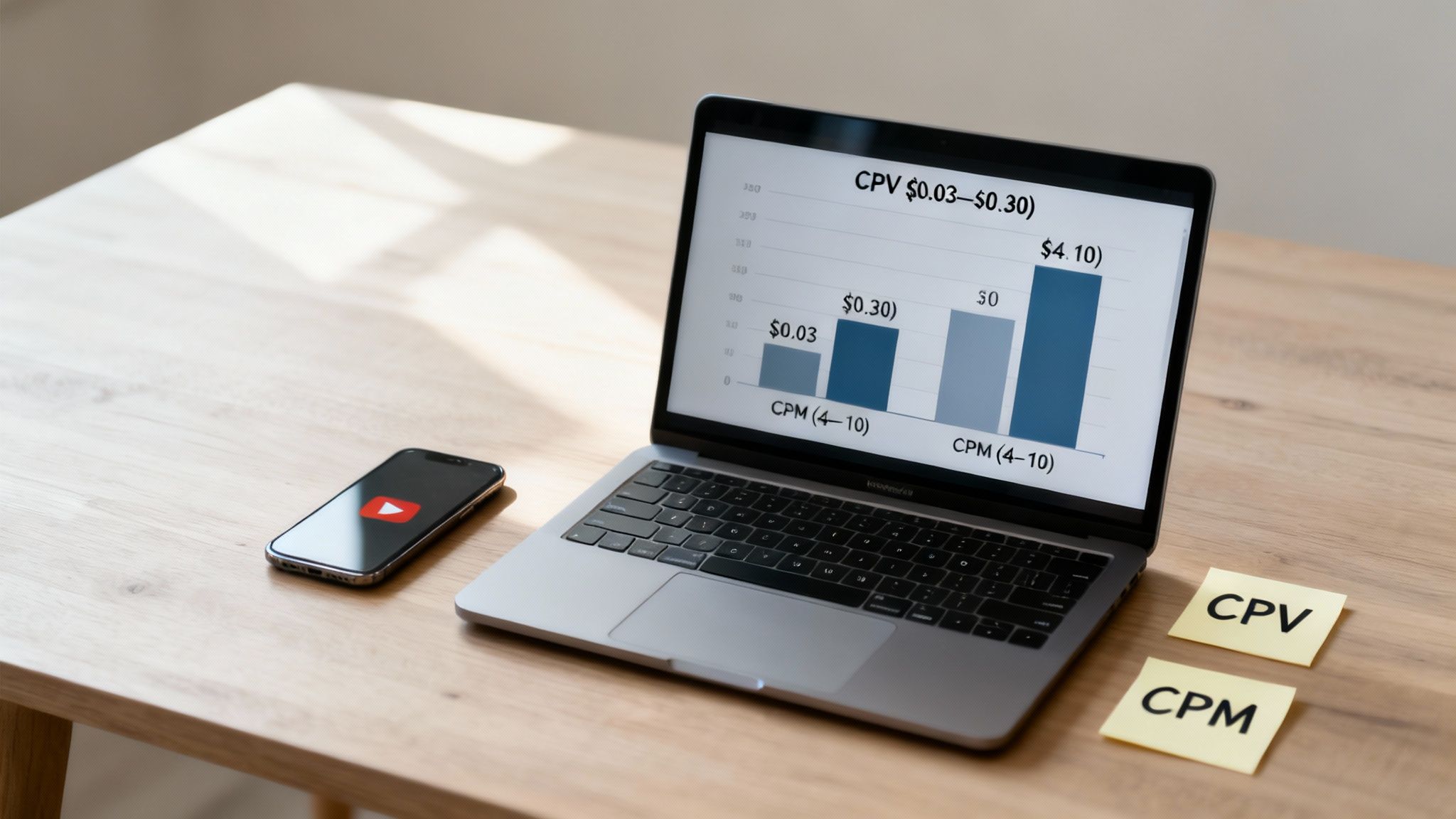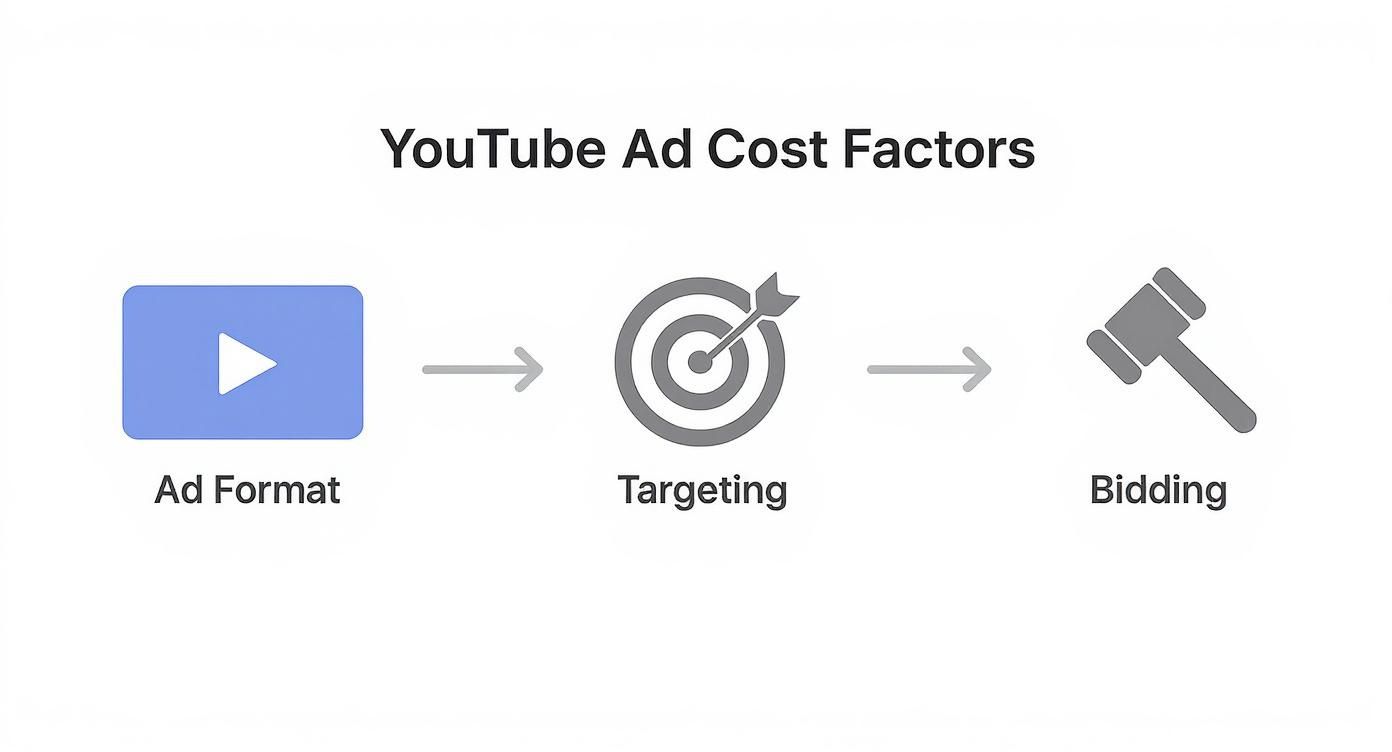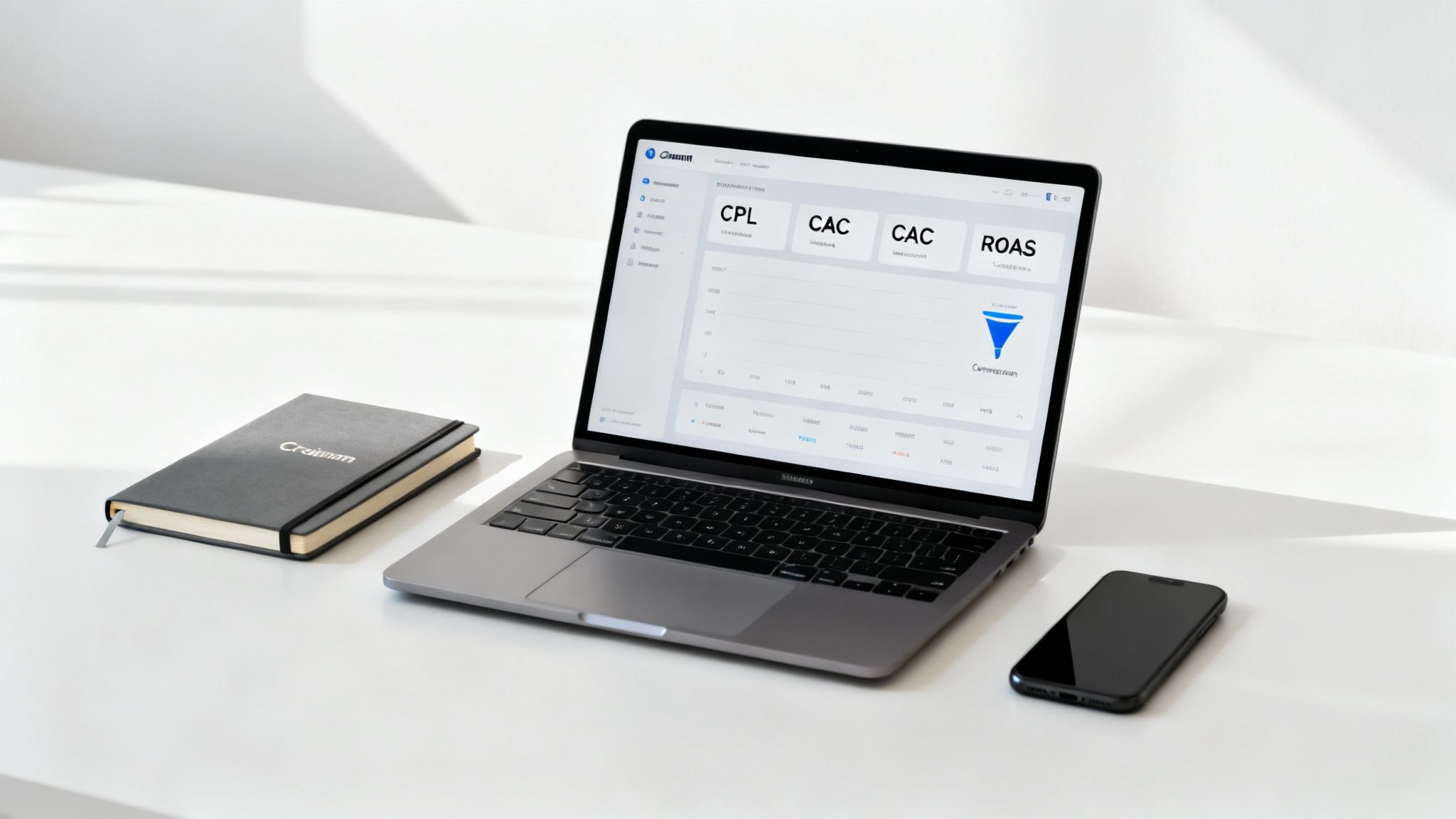Let's get straight to the point: how much does a YouTube ad cost? While there's no single price tag, most businesses can expect to pay between $0.03 to $0.30 per view using the Cost Per View (CPV) model. For campaigns focused on brand awareness, the typical Cost Per Mille (CPM) ranges from $4 to $10 per 1,000 impressions.
Your Guide to YouTube Ad Costs

Determining YouTube's pricing isn't like picking from a menu. It’s a dynamic auction where the cost of a viewer's attention changes based on your goals, target audience, and industry. Your budget isn't a fixed expense but a strategic investment designed to achieve specific business outcomes.
This flexible pricing is what makes YouTube so powerful. You're not just buying a static ad slot; you're bidding for the opportunity to engage a specific person at the perfect moment. This gives you immense control over your spending, allowing you to tie your budget directly to objectives like generating leads, driving website traffic, or simply boosting brand recognition.
Breaking Down the Core Pricing Models
You'll primarily encounter two pricing models: CPV and CPM. Each serves a different strategic purpose and directly influences your total ad spend. We've created a simple table to illustrate the difference.
Typical YouTube Ad Cost Ranges by Model
As you can see, the right model depends entirely on your campaign's goals.
Here’s a closer look at each:
Cost Per View (CPV): This is the most common model. You pay only when someone watches your ad for at least 30 seconds (or its entirety if shorter) or interacts with it. It’s ideal for campaigns where capturing genuine interest and prompting action is the priority.
Cost Per Mille (CPM): With this model, you pay for every 1,000 times your ad is displayed, regardless of whether it's watched. This is the go-to option when the primary goal is pure visibility and getting your brand in front of the largest possible audience.
Aligning Costs with Your Business Goals
Ultimately, your choice between these models hinges on your objectives. If you need to drive qualified leads to your website for a product demo, a CPV strategy is the logical choice because you're paying for engaged viewers.
Conversely, if you're launching a new product and need to generate immediate buzz, a CPM campaign will deliver the broad exposure you need.
Mastering these fundamentals is the first step toward building a YouTube ad strategy that delivers results without overspending. It's also useful to see how these costs compare to other platforms. For additional context, review our complete guide to social media marketing cost to understand where YouTube fits in the broader digital landscape.
Understanding How YouTube Prices Your Ads
To truly grasp how much a YouTube ad costs, you must look beyond the averages and understand the mechanics. It’s less like a fixed-price purchase and more like a live auction for your audience’s attention. The final price you pay is a result of your campaign goals, the level of competition, and the pricing model you select.
Think of each model as a different tool in your financial toolkit, each designed for a specific job. Making the right choice is the first step toward building a campaign that works without depleting your budget. Let’s explore the core models you’ll be working with.
The Foundation: Cost Per View (CPV)
Cost Per View (CPV) is the cornerstone of YouTube advertising, especially for driving engagement and consideration. With CPV, you only pay when a viewer actively engages with your ad. This typically means they either watch at least 30 seconds of your video (or the full ad if it's shorter) or click on an interactive element.
This model is effective because it naturally filters out uninterested viewers. You aren’t charged for every impression, only for viewers who demonstrate genuine interest.
A CPV campaign is like paying a small fee for someone to read your entire flyer, word for word. You're paying for their focused attention. Other models are more like paying a flat rate to have that same flyer slapped on a thousand car windshields, with no idea if anyone will even glance at it.
This direct link between spend and engagement makes CPV an excellent choice for driving actions like website visits, product consideration, or lead form submissions.
The Awareness Builder: Cost Per Mille (CPM)
While CPV prioritizes engagement, Cost Per Mille (CPM) is all about reach. "Mille" is Latin for a thousand, so with this model, you pay a set price for every 1,000 times your ad is displayed. It doesn't matter if it's watched or clicked—you're paying for the impression.
CPM is the engine that powers large-scale brand awareness campaigns. It’s perfectly suited for ad formats designed for quick impact, like the unskippable six-second bumper ads or longer non-skippable in-stream ads. If your main objective is to place your brand name, logo, or a key message in front of as many relevant people as possible, CPM is your most efficient option.
Situational Models for Specific Goals
Beyond the two primary models, YouTube offers other pricing options for more specific, conversion-focused goals. While less common for pure video campaigns, knowing when to use them can add another layer of precision to your strategy.
Here are two others you should know:
Cost Per Click (CPC): This functions just as it does in search advertising. You are charged only when a viewer clicks on your ad, such as a companion banner or a call-to-action button. It’s the preferred model when your primary goal is driving traffic directly to a landing page. For more insight, our guide on what is paid search advertising explains how this concept works across different platforms.
Cost Per Action (CPA): Sometimes called Cost Per Acquisition, CPA is the most performance-driven model. You set a target price you’re willing to pay for a specific conversion—like a sale, a software trial sign-up, or a completed lead form. YouTube’s algorithm then works to deliver those actions at or below your target cost. This model directly ties your ad spend to tangible business outcomes, making it ideal for bottom-of-the-funnel campaigns where ROI is the ultimate metric.
Ever wonder why one business pays $0.05 per view for their YouTube ad while a competitor shells out $0.25? It’s not random. The final price tag is the result of several interconnected factors you can actively manage.
Understanding these variables is the key to controlling your budget and answering the critical question: how much will YouTube ads cost for your specific goals?
Think of it like mixing a track in a recording studio. Every lever you adjust—ad format, targeting, bidding strategy, and even your industry—changes the final output. Mastering these controls means you stop just spending money and start making calculated investments.
Let's break down the four biggest factors that influence your costs.
Your Choice of Ad Format
The type of ad you run is one of the first and most critical decisions impacting your budget. Each format is priced differently because it serves a different purpose and offers a unique viewer experience.
For example, a quick six-second, unskippable bumper ad is usually purchased on a Cost Per Mille (CPM) basis, where you pay per thousand impressions. Its goal is pure brand awareness—a quick, memorable flash.
Conversely, a skippable in-stream ad is typically bought on a Cost Per View (CPV) basis. You only pay when someone shows genuine interest by watching for 30 seconds or clicking. This engagement-based model naturally has a different cost structure than one based on impressions alone.
The Precision of Your Audience Targeting
This is where the real power—and potential cost—of YouTube advertising comes into play. The more specific and valuable your target audience is, the more you can expect to pay. Why? Because you're competing with other advertisers who also want to reach that same high-value group.
Imagine targeting a broad demographic like "males aged 18-34 in the United States." The audience pool is vast, so the cost per view might be relatively low.
Now, consider a B2B scenario targeting a niche group: "C-level executives in the cybersecurity industry who have recently visited financial news websites." This audience is smaller and incredibly valuable to a select group of advertisers. The intense competition for their limited attention drives the auction price up significantly.
While granular targeting can increase your cost-per-view, it almost always dramatically improves your ROI. You stop burning cash on irrelevant eyeballs and make sure every dollar is spent reaching people who could actually become customers.
Your Bidding Strategy and Campaign Goals
Your bidding strategy is essentially how you instruct Google’s ad auction on what you value most. It dictates how much you're willing to pay for a specific outcome and directly impacts your final ad spend.
Here’s how different strategies affect costs:
- Maximize Views: This tells the algorithm to secure the most views possible within your daily budget. It’s perfect for building initial awareness as it seeks the lowest-cost views available.
- Target CPV: Here, you set a maximum price you're willing to pay for a single view. This gives you more direct control and prevents per-view costs from spiraling.
- Target CPA (Cost Per Action): This advanced strategy focuses purely on conversions. You tell Google how much you’re willing to pay for a specific action, like a form submission, and it optimizes bidding to meet that target. This often results in higher per-view costs, but your cost-per-lead becomes far more efficient.
Market Competition and Industry Demand
Finally, some factors are outside your direct control, namely the level of competition in your market and the time of year. The YouTube ad auction is a dynamic marketplace where demand constantly shifts.
Advertising in a competitive industry like finance or B2B SaaS will almost always be more expensive than in a less crowded niche.
Similarly, costs tend to rise during peak seasons like the Q4 holiday rush (think Black Friday) or around major industry events. More advertisers enter the auction, driving up prices for everyone. That’s why strategically timing your campaigns is so important. YouTube ad campaign costs can vary significantly, but a common average CPV lands between $0.05 and $0.10 for many industries—a figure that is influenced by these exact factors. You can get a better sense of budget ranges from reports on YouTube ad costs in 2025 to see how it plays out in the real world.
How to Forecast Your YouTube Ad Budget
Knowing the average cost of a YouTube ad is a good starting point, but building a predictable budget requires a more strategic approach. It’s time to move from theory to practice with a clear framework that connects your ad spend directly to your business goals. Let’s stop guessing and start forecasting.
This process is less intimidating than it sounds. By working backward from your lead generation targets, you can create a realistic financial plan that supports your growth objectives. We'll walk through a practical B2B scenario to demonstrate how it’s done.
Think of your ad cost as the result of a few key upfront decisions. The ad format, target audience, and bidding strategy all work together to determine your final spend.

As you can see, every choice you make in these three areas has a direct impact on your campaign budget.
Step 1: Define Your Campaign Objective
First, you need a specific, measurable goal. A vague objective like "get more leads" isn't actionable. A strong, clear objective sounds more like: "Generate 25 qualified leads for our B2B SaaS platform this month."
This clarity is crucial. It establishes a clear target, and every subsequent calculation will be based on achieving that number.
Step 2: Estimate Views Needed with Benchmarks
Next, we need to determine how many video views are required to hit that lead target. If you don't have historical data, industry benchmarks are a reliable starting point.
For many B2B industries, a solid landing page conversion rate from engaged video traffic is around 2-5%. Let’s be conservative and start with 2%.
- Calculation: (Target Leads / Conversion Rate) = Clicks Needed
- Example: 25 Leads / 0.02 = 1,250 Clicks
So, we need 1,250 clicks. How many views will that take? A typical click-through rate (CTR) for a well-targeted YouTube ad is approximately 0.5%.
- Calculation: (Clicks Needed / CTR) = Total Views Needed
- Example: 1,250 Clicks / 0.005 = 250,000 Views
There you have it. To generate 25 qualified leads, your campaign needs to aim for approximately 250,000 engaged views.
Step 3: Calculate Your Total Ad Budget
The final step is to convert those required views into a real dollar amount. This is where the average Cost Per View (CPV) comes in. As we've discussed, CPV can range from $0.03 to $0.30, but a reasonable starting point for a targeted B2B campaign is around $0.15 per view.
The Simple Budget Formula:
Total Views Needed × Average CPV = Estimated Total Budget
Let's plug our numbers into the formula to complete the forecast:
- Calculation: 250,000 Views × $0.15 CPV = $37,500 Total Budget
This isn't just a number pulled from thin air. It’s a data-informed estimate tied directly to your business objective, providing a solid foundation for your campaign and a benchmark to measure performance against.
Sample B2B YouTube Ad Budget Calculation
To make this even clearer, here’s the entire forecast laid out in a table. You can use this as a template for your own planning by swapping in your own numbers and goals.
Of course, your actual results will vary. Your ad creative might outperform expectations and achieve a higher CTR, or your landing page could convert at a better rate. This forecast is a starting point, not a guarantee. The real power comes from launching, tracking results, and adjusting your strategy based on real-world data.
To better understand performance measurement, see our guide on how to calculate return on ad spend for a deeper look into campaign profitability.
Getting the Most Out of Your YouTube Ad Spend
Launching your campaign is just the beginning. The real work in controlling your YouTube ad cost happens through continuous, data-driven optimization. Success isn't about setting a budget and hoping for the best; it's about relentlessly refining your approach to make every dollar more effective.
Think of your initial campaign setup as an educated hypothesis. Now, the work begins to turn that hypothesis into a high-performance engine that drives down costs while maximizing results. Here’s how you transform a good campaign into a great one.
A/B Test Your Ad Creatives Relentlessly
Never assume you know which ad will resonate with your audience. The only way to know for sure is to test different versions of your creative.
Try varying key elements to see what connects:
- The Hook: Start your video with a compelling question, a bold statement, or a surprising statistic. The first five seconds are critical.
- The Call-to-Action (CTA): Experiment with your request. Does "Book a Demo" outperform "Download the Guide"? Or is "Learn More" the winner? You won't know until you test.
- Visuals and Tone: Pit a fast-paced, high-energy edit against a more story-driven version. Different styles appeal to different viewers.
By systematically testing and allocating your budget to the winning ads, you can significantly lower your Cost Per View and Cost Per Lead. For more creative inspiration, explore our deep dive into the power of video in social media marketing.
Sharpen Your Targeting and Placements
Your initial audience is a solid foundation, but performance data will quickly reveal who is truly engaged. Dive into your YouTube Analytics to identify the demographic segments, interests, and locations that are performing best, and double down on them.
At the same time, be ruthless about eliminating wasted spend. This is where negative targeting becomes invaluable.
Actively use negative keywords and placement exclusions. This stops your ads from appearing on irrelevant channels or alongside content that doesn't align with your brand. It's like weeding a garden—this simple act plugs budget leaks and ensures your message only reaches a receptive audience.
For instance, if you're selling B2B software, you should exclude channels aimed at children or entertainment topics unrelated to your industry. This precision is what drives a higher ROI.
Adjust Your Bids and Schedule Based on Performance
Your bidding strategy should not be static. As data accumulates, you'll notice patterns that you can leverage. If you discover that conversion rates are higher on weekdays, consider bidding more aggressively during that time.
It's also crucial to understand how costs fluctuate. The competition for ad space is always changing, directly impacting your bottom line. For example, historical data shows the average CPM climbing from $5.72 in October 2023 to a projected $7.61 by October 2025. Costs can even vary by day—Thursdays are often the most expensive, while weekends may offer lower CPMs. By strategically scheduling your campaigns to run when costs are lower and your audience is more engaged, you can make your budget go much further. You can read the full research on these social media ad cost trends to help make smarter scheduling decisions.
Measuring Success Beyond Clicks and Views

While it's tempting to chase a lower YouTube ad cost, fixating on metrics like views and clicks alone can be misleading. These are often vanity metrics—they look impressive in a report but don’t directly contribute to revenue.
True success is measured by what happens after the click. It requires shifting your mindset from "how much did I spend?" to "how much business did I generate?" This means looking beyond YouTube’s native analytics to see the entire customer journey, from first impression to final sale.
Connecting the Dots with Integration
To gain a complete picture, integrating your ad platforms with your core business systems is essential. This creates a seamless data pipeline, allowing you to trace a customer from their first ad view all the way to a closed deal.
Two integrations are particularly critical:
- Google Analytics: Linking YouTube Ads to Google Analytics lets you see how users behave once they reach your website. Are they staying long? Which pages do they visit? Are they converting? This provides a clear window into your traffic quality.
- Customer Relationship Management (CRM): This is the real game-changer. Connecting your campaigns to a CRM like Salesforce or Dynamics 365 allows you to see which ads are generating not just leads, but high-quality leads that convert into actual revenue.
This level of integration distinguishes a basic campaign from a strategic, growth-driving machine. It provides the data needed to make smarter decisions about your budget, creative, and targeting.
Focusing on the KPIs That Truly Matter
Once your systems are integrated, you can move beyond obsessing over Cost Per View (CPV) and start tracking the key performance indicators (KPIs) that reflect the health of your business. These metrics tell the full financial story of your campaigns.
The ultimate goal isn't just to lower your YouTube ad cost; it's to maximize your return. By focusing on bottom-line metrics, you ensure that every dollar spent is an investment in measurable growth, not just a payment for fleeting attention.
Here are the three essential metrics you should be laser-focused on:
- Cost Per Lead (CPL): This tells you exactly how much you're spending to acquire one lead from your campaign. Calculated by dividing your total ad spend by the number of leads generated, it’s a direct measure of your lead acquisition efficiency.
- Customer Acquisition Cost (CAC): Taking it a step further, CAC calculates the total cost to acquire a paying customer. This includes your ad spend plus any other sales and marketing costs, giving you a holistic view of what it really costs to win new business.
- Return on Ad Spend (ROAS): This is the ultimate metric. ROAS measures the total revenue generated for every dollar you spend on advertising. A high ROAS is the ultimate confirmation that your YouTube ads are a profitable engine for growth, not just a cost center.
By tracking these KPIs, you can confidently answer the question "how much does a YouTube ad cost?" with a much more powerful one: "how much revenue are my YouTube ads producing?" For a deeper dive, our guide on measuring social media ROI offers more frameworks for proving the true value of your campaigns.
Your Top Questions About YouTube Ad Costs, Answered
When exploring YouTube advertising, a few practical questions about cost and value inevitably arise. Here are straightforward answers to the most common queries.
What’s a Good Daily Budget to Start With?
For most small to medium-sized businesses, a daily budget between $10 and $50 is an excellent starting point.
Think of this initial budget as your "data-gathering" fund. It’s sufficient to learn what works—which ads get clicks, which audiences convert—without a major financial commitment. Once you have this initial data, you can scale your investment with confidence.
Is YouTube Cheaper Than Facebook or LinkedIn Ads?
The comparison is less about which platform is "cheaper" and more about the value of the engagement you purchase. This is where YouTube often excels.
While direct cost comparisons can be complex, YouTube's value often lies in its Cost Per View (CPV) model. You're not just paying for a fleeting impression in a crowded feed; you're paying for a viewer who chose to watch your ad. That level of engagement can be far more cost-effective for building genuine interest and consideration.
Here are some typical cost ranges:
- YouTube: Averages around $0.10 - $0.30 per view.
- Facebook/Instagram: Clicks typically range from $0.25 - $2.00.
- LinkedIn: As a premier B2B platform, clicks are more expensive, averaging $5.26.
The platform that delivers the best return for your specific goals is the one that is truly "cheaper" for your business.
Can I Actually Get Results with a Small Budget?
Absolutely. A smaller budget forces you to be strategic, which is a significant advantage. You don’t need a massive budget to make an impact on YouTube.
The key is focus. Instead of trying to reach everyone, get hyper-specific. Target a narrow, highly relevant audience with a clear conversion goal. This ensures every dollar is spent reaching people most likely to become customers, rather than being diluted across a broad, uninterested audience.
Ready to stop guessing and start building a YouTube ad strategy that actually drives revenue? Twelverays specializes in creating data-driven campaigns that tie directly to your bottom line. Let's build a campaign that delivers real results.





